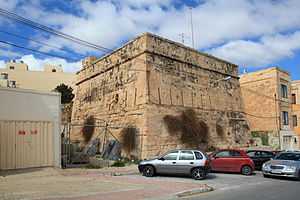Redoubt
.png)
A redoubt (historically redout)[1][2] is a fort or fort system usually consisting of an enclosed defensive emplacement outside a larger fort, usually relying on earthworks, although others are constructed of stone or brick.[3] It is meant to protect soldiers outside the main defensive line and can be a permanent structure or a hastily constructed temporary fortification. The word means "a place of retreat".[2] Redoubts were a component of the military strategies of most European empires during the colonial era, especially in the outer works of Vauban-style fortresses made popular during the 17th century, although the concept of redoubts has existed since medieval times. A redoubt differs from a redan in that the redan is open in the rear, whereas the redoubt was considered an enclosed work.[4]
The advent of mobile warfare in the 20th century generally diminished the importance of the defence of static positions and siege warfare.
Historically important redoubts
Wars of the Three Kingdoms
During the Wars of the Three Kingdoms redoubts were frequently built to protect older fortifications from the more effective artillery of the period. Often close to ancient fortifications there were small hills that overlooked the defences, but in previous centuries these had been too far from the fortifications to be a threat. A small hill close to Worcester was used as an artillery platform by the Parliamentarians when they successfully besieged Worcester in 1646. In 1651 before the Battle of Worcester the hill was turned into a redoubt by the Royalists, (the remains of which can be seen today in Fort Royal Hill Park). During the Battle of Worcester, the Parliamentarians captured this redoubt and turned its guns on Worcester. In so doing they made the defence of the city untenable. This action effectively ended the battle, the last of the English Civil War.
Malta

From 1715 onwards, the Order of Saint John built a number of redoubts in Malta, as part of an effort to improve the coastal fortifications of the islands. They were built in the middle of bays to prevent enemy forces from disembarking and outflanking the coastal batteries.[5]
The design of the redoubts was influenced by ones built in the French colonies. In all, eleven pentagonal redoubts and a few semi-circular or rectangular ones were built. Most redoubts have been demolished over the years, but a few still survive, such as Ximenes Redoubt.[6]
Four tour-reduits were also built. These were redoubts built in the form of a tower, with rows of musketry loopholes. Three were around Marsaxlokk Bay, and one was located in Marsalforn, Gozo. The only one still in existence is Vendôme Tower in Marsaxlokk.[7]
During the siege of Malta of 1798-1800, Maltese insurgents built a number of fortifications to bombard French positions and repel a possible counterattack. Most of the fortifications were batteries, but at least two redoubts, Windmill Redoubt and Żabbar Redoubt, were built. In 1799, British forces also built San Rocco Redoubt and Saint Lucian Redoubt in Malta. No redoubts from the French blockade survive today.[8]
Other important redoubts

See the Battle of Poltava (1709), the Battle of Bunker Hill (1775), the Battle of Yorktown (1781) where Alexander Hamilton led his only military command against a British redoubt, the Lines of Torres Vedras of the Peninsular War (1809–1810), the Harwich Redoubt (1809-1810), the Battle of Borodino (1812), the Charge of the Light Brigade (1854), the Railroad Redoubt of the Battle of Vicksburg (1863), the Battle of Plevna (1877-1878), the Battle of Rorke's Drift (1879), and during World War I the "National Redoubt of Antwerp" (1914), the German Hohenzollern Redoubt as well as the Hawthorn Ridge Redoubt (1916) and the Vercors plateau redoubt used by the Free French Forces in World War II, are examples where redoubts played a crucial role in military history.
"National redoubt"
A national redoubt is an area to which the remnant forces of a nation can be withdrawn if the main battle has been lost, or beforehand if defeat is considered inevitable. Typically a region is chosen with a geography favoring defense, such as a mountainous area or a peninsula, in order to function as a final hold-out to preserve national independence for the duration of the conflict.
See also
References
- ↑ "Browse 1828 => Word REDOUT :: Search the 1828 Noah Webster's Dictionary of the English Language". 1828.mshaffer.com. 3 June 2012. Retrieved 3 June 2012.
- ↑ 2.0 2.1 "Online Etymology Dictionary: redoubt". Etymonline.com. Retrieved 6 September 2012.
- ↑ "Dictionary of Fortifications: Redoubt". Civil War Field Fortifications Website. September 2005. Archived from the original on 28 July 2013.
- ↑ "Field Fortification: On The Trace Of Field Fortifications". Civil War Field Fortifications Website. March 2003. Archived from the original on 9 January 2010.
- ↑ Debono, Charles. "Coastal Redoubts". Mellieha.com. Retrieved 23 April 2015.
- ↑ Spiteri, Stephen C. (10 April 2010). "18th Century Hospitaller Coastal Batteries". MilitaryArchitecture.com. Retrieved 23 April 2015.
- ↑ "Vendôme Tower" (PDF). Mare Nostrum. Retrieved 23 April 2015.
- ↑ Spiteri, Stephen C. (May 2008). "Maltese ‘siege’ batteries of the blockade 1798-1800" (PDF). Arx - Online Journal of Military Architecture and Fortification (6): 30–46. Retrieved 23 April 2015.
External links
| Wikimedia Commons has media related to Redoubts. |
| Look up redoubt in Wiktionary, the free dictionary. |
| ||||||||||||||||||||||||||||||